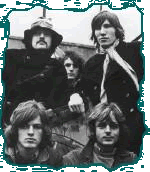
Over the thirty-five years its existance, the band Pink Floyd has had the following members (with their dates of birth) :
* Roger Keith (Syd) Barrett, January 6, 1946 - July
7, 2006
* George Roger Waters, September 9, 1943
* Richard William (Rick) Wright, July 28, 1945
* Nicholas Berkeley (Nick) Mason, January 27, 1945
* David Jon (Dave) Gilmour, March 6, 1946
|
|
While studying for his degree, Syd Barrett, the original lead guitarist, met Roger Waters, the bass player, Rick Wright a budding keyboardist and a drummer by the name of Nick Mason, all three of whom were studying at the London Technical College for Architecture. They were all from Cambridge except Rick Wright, who was a Londoner. Waters and Mason were friends at school and had spent most of their teenage life together.
Till late 1965, the four original members, as a band with some others, played mostly rhythm and blues, calling themselves, in turn, "Sigma 6", "The T-Set" ("Tea Set"), "The Meggadeaths", "The Architectural Abdabs", "The Screaming Abdabs", and then just "The Abdabs". In late 1965, Syd Barrett named the band Pink Floyd - a merge of the albums of two Carolina blues bands - Pink Anderson and the Floyd Council - that Syd Barrett had in his collection. It was Syd who became the main influence on Pink Floyd's music with him being the song writer and lead singer and playing the guitar, and the start of the Psychedelic Music movement of the late 1960's is attributed to him. Pink Floyd became very popular in underground hangouts. As Floyd biographer Miles has said about this period, "The Floyd were the loudest band anyone had ever heard at that time. They were also the weirdest. They were the underground band." The growing undergorund popularity led to the release of the single "Arnold Layne" in March 1967, which reached #20 in the British charts. This was followed by the single "See Emily Play" and then their first album, "The Piper at the Gates of Dawn" - both of which stayed on the charts for 7 weeks reaching #6, with Pink Floyd being seen as a cult underground group.
It was at this time that the members of PF became heavily involved in drugs, especially acid. It was once said that the amount of acid PF took in this period could wipe out the population of a small country. Founder Syd Barrett almost had a mental breakdown due the amount of drugs he was taking and he was replaced by his friend from Cambridge, who had a major influence on Syd's style of guitar playing - David Gilmour. PF's next album "A Saucer Full of Secrets" was a mix of both Barrett's and Gilmour's work, but was not as successful as their first album. People viewed this as the demise of the Pink Floyd light and sound extravaganzas. Or was it?
In the period between 1968 and 1970, the early years after the departure of Barrett, it seemed people were right and Pink Floyd struggled to find popularity without their main player. It is at this time that the bass player Roger Waters started to become the song writer. The newcomer Gilmour started to compose, too. The group continued its psychedelic roots but the element of Gilmour's steady distinct guitar playing began to emerge with the new work, which was apparent on their new album "Ummagumma", which is slang in the western country for sex. This album showed the inability of PF to compose the short pop gems Barrett could, but instead it contained long instrumentals such as "Set the Controls for the Heart of the Sun". This theme was continued in "Atom Heart Mother" which contained a 27 minute title piece as well as "Alan's Psychedelic Breakfast" which was a 15 minute instrumental. At this point people were beginning to realise how good PF were, and in this transitional period they became popular across both sides of the Atlantic. Their next release "Relics", which contained a lot of Barrett's music, and the release after that - "Meddle" - which contained another 23 minute instrumental got acclaims from both America and England. But the best was still to come.
To many people the next 5 years after 1970 are the glory years of Pink Floyd, and without a question the best years of Pink Floyd as a cohesive band unit. "Meddle" in 1971 reached #1 in the albums chart, with PF choosing not to play to the singles market. In mid 1972 PF released "Obscured by Clouds", but this was only a lead up to the greatest ever success of PF, and probably any band, with the release of the album "Dark Side of the Moon" - which will go down in history as the greatest music composed in the 20th century.
After "Wish You Were Here", Pink Floyd again changed their style of music, with Roger Waters becoming the main composer of PF. The next album following this period of success was "Animals" which reached #3 in the British album charts, this album is significant because it is the first album without the keyboardist Rick Wright credited for any composition. The ensuing stadium tour, whose environment Waters did not like, became very popular; but it is this tour which is credited with the next big hit album - "The Wall". In 1978 both Wright and Gilmour released solo material due to the lack of work.
So now we have come from the "Dark Side of the Moon" album where the Floyd are working together, under the directorship of all of the members in the band, to members of the band releasing solo work because of their lack of work as Waters has become 'the leader'. This period starts the downfall of Waters who eventually leaves the band for what he believes dead.
In 1979 Pink Floyd reconvene to produce 'The Wall' which is a Waters brain child. Bob Erzin is hired to stop the fights between Gilmour and Waters and Waters tries to sack their long time manager Steve O'Rouke as Waters becomes a dictator character in the band. As this feeling builds up inside of Waters, he decides that if the keyboardist Rick Wright does not leave the band, he will scrap the project and as a result Wright misses the final studio sessions of the album. But in a twist Wright is hired for the following stadium tour to give the look that the band is intact. In 1982 a film is made of the album, with Bob Geldof starring as Pink, but the project becomes disliked by Waters after directorial decisions by its director Alan Parker.
At this point due to the attitude of Waters that without him, Pink Floyd are nothing, Pink Floyd are almost really reduced to nothing.
In 1983 the band releases "The Final Cut", which is lyrically an amazing album. Surprisingly, it receives criticism from many PF fans as the worst album. This opinion is reinforced when sales of the album fail to reach even the prior efforts of the band. Mason and Gilmour are used on the album only sparingly and Wright in non-existent; the album is a Pink Floyd creation only by name. This is the end of Waters and he formally leaves the band in 1985 saying that Pink Floyd are dead because he is not there.
In 1986 Mason and Gilmour revive Pink Floyd after a bitter Waters unsuccessfully tries to stop the comeback in court. The duo which is now Pink Floyd come back with a massively successful "A Momentary Lapse of Reason", which has a crack team of studio artists for the album, and towards the end Wright is hired to continue with the band, but as a paid member, not as a member of the band. The tour following the album is more successful than PF's highest hopes, taking three years to complete with its climax playing to 200,000 in Venice on a floating stage. But Waters is still not finished; when after the Berlin Wall comes down in 1990, he performed 'The Wall' in the no-man's land between East and West, but with big stars, not Pink Floyd members.
After a long break, Pink Floyd returned with "The Division Bell", with Wright now a full time member of the band with Gilmour and Mason. The three work together as a cohesive unit for the first time since "Wish You Were Here". "Division Bell" reaches #1 in the US and UK and the following tour, which is, as always a masterpiece of modern lighting, pyrotechnics and stage presence grosses over one billion dollars in the US alone.
Following this they release "Pulse" in 1995 which reaches #1 again in the US and UK featuring Division Bell tracks and the first live performance of Dark Side of the Moon since Waters left.
But now the fans of Pink Floyd are left wondering what will come next, but in the meantime an enigma has been put on the "Division Bell" , mainly contrived by PF's friend, the author Douglas Adams, who regularly posts on to the Pink Floyd newsgroup informing the group of the present details of Pink Floyd's activities.
So what have Pink Floyd achieved over the last 30 years? Nick Mason has got his dream collection of 20 Ferrari's, worth over $25 million; Dave Gilmour has the StratoCaster Guitar number 001. But on a wider note Pink Floyd have started the trend to computerize music which they strove to produce in the 60's; they have set the example for what stadium based concerts should consist of with their amazing lighting and sound shows. A range of VW Golfs based on PF, millions and millions of pounds of money; what more can you ask for.
JavaScript DHTML Menu Powered by Milonic (License)
